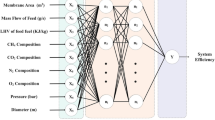Abstract
This work presents an approach to the modeling of a real industrial isomerization reactor by using artificial neural networks (ANN) pre-processed with principal component analysis (PCA). The initial model considered the output fructose concentration as the output variable, while the flow rate of substrate to the reactor as the principal input variable. Then, the ANN model was restructured and inversely trained by assuming the exit fructose concentration as the input variable and the feed flow rate as the output variable. Results indicate good performance by the application of the developed strategy to an extensive industrial data set. The results are expected to be useful in future, controlling the fructose concentration in the HFCS isomerization reactor.










Similar content being viewed by others
Explore related subjects
Discover the latest articles and news from researchers in related subjects, suggested using machine learning.References
Asif M, Abaseed AF (1998) Modelling of glucose isomerization in a fluidized bed immobilized enzyme bioreactor. Bioresour Technol 64:229
Cancilla DA, Fang X (1996) Evaluation and quality control of environment analytical data from the Niagara River using multiple chemometric method. J Great Lagoons Res 22:241
Coker LE, Venkatasubramanian K (1987) Corn sweeteners. In: Knorr D (ed) Food biotechnology. Marcel Dekker Inc., New York, 443
Doty TE, Vanninen E (1975) Crystalline fructose. Use as a food ingredient expected to increase. Food Technol 29:34
Golden RM (1996) Mathematical methods for neural network analysis and design, 1st edn. MIT Press Cambridge, MA, USA
Grossberg S (1988) Nonlinear neural networks: principles, mechanisms, and architectures. Neural Netw 1:17
Hagan T, Demuth HB, Beale M (1996) Neural network design (Thomson Learning USA)
Haykin S (1999) Neural networks, a comprehensive foundation, 2nd edn. Prentice Hall, USA
He F, Ma C (2010) Modeling greenhouse air humidity by means of artificial neural network and principal component analysis. Comput Electron Agric 71(1):S19
Holcomb TR, Morari M (1992) PLS/neural networks. Comput Chem Eng 16(4):393
Holman JP (1971) Experimental methods for engineers. McGraw-Hill Book Company, New York. http://www.freepatentsonline.com/5350456.html
Jacobs RA (1988) Increased rates of convergence through learning rate adaptation. Neural Netw 1:295
Kanjilal PP (1995) On the application of orthogonal transformation for design and analysis of feedforward networks. IEEE Trans Neural Netw 6:1061
Kappen HJ (1996) An overview of neural network applications. In: Proceedings sixth ICCTA, Wageningen, the Netherlands, p 75
Kashani MN, Shahhosseini S (2010) A methodology for modeling batch reactors using generalized dynamic neural networks. Chem Eng J 159(1–3):195
Kosaric N, Cosentino GP, Wieczorek A (1984) The Jerusalem artichoke as an agricultural crop. Biomass 5:1
Levenberg K (1994) A method for the solution of certain problem in least squares. Quart Appl Math 2:166
Maier HR, Dandy GC (2000) Neural networks for prediction and forecasting of water resources variables: a review of modelling issues and applications. Environ Model Softw 15:101
Mjalli FS, Al-Asheh S, Alfadala HE (2007) Use of artificial neural network black-box modeling for the prediction of waste water treatment plants performance. J Environ Manag 83:329
Morris AJ, Montague GA, Willis MJ (1994) Artificial neural networks: studies in process modelling and control. Trans IchemE 72A:3
Oliveira-Esquerre KP, Mori M, Bruns RE (2002) Simulation of an industrial wastewater treatment plant using artificial neural networks and principal components analysis. Braz J Chem Eng 19(4):365
Palazzi E, Converti A (1999) Generalized linearization of kinetics of glucose isomerization to fructose by immobilized glucose isomerase. Biotechnol Bioeng 63(3):273
Rechigl M (1982) Handbook of nutritive value of processed foods Boca Raton, FL, pp 80–81
Takors R, Bathe B, Rieping M, Hans S, Kelle R, Huthmacher K (2007) Systems biology for industrial strains and fermentation processes—Example: amino acids. J Biotechnol 129(2):181
The Mathworks Inc 2003. http://www.mathworks.com
US Patent 5350456 (1994). Integrated process for producing crystalline fructose and a high fructose, liquid-phase sweetener
Wei L, Wang FA, Liu Y, Chai Y (2009) LB energy-saving high temperature shift catalyst and its adsorption thermodynamics. Korean J Chem Eng 26(1):42
White JS (1992) Fructose syrup: production, properties and applications. In: Schenck FW, Hebeda RE (eds) Starch hydrolysis products—Worldwide technology, production, and applications. VCH Publishers, Inc, Weinheim, p 177
Zhang Y, Hidajat K, Ray AK (2004) Optimal design and operation of SMB bioreactor: production of high fructose syrup by isomerization of glucose. Biochem Eng J 21:111
Acknowledgments
The author acknowledges the industrial data provided by CARGILL Inc. Orhangazi-Turkey through Yontem Beyazkus and Ercan Erdas.
Author information
Authors and Affiliations
Corresponding author
Rights and permissions
About this article
Cite this article
Yuceer, M. Artificial neural network models for HFCS isomerization process. Neural Comput & Applic 19, 979–986 (2010). https://doi.org/10.1007/s00521-010-0437-x
Received:
Accepted:
Published:
Issue Date:
DOI: https://doi.org/10.1007/s00521-010-0437-x




